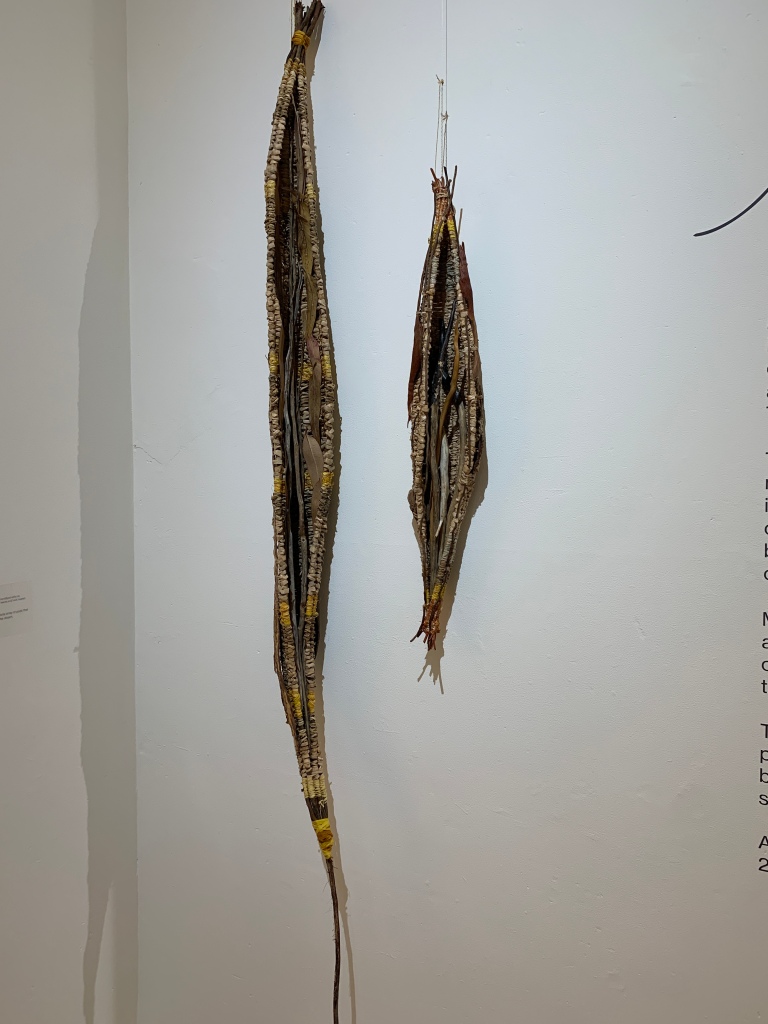On a cool Friday afternoon I found myself with a few hours spare and a husband to look after the kids. I went to the Broken Hill Art Gallery to see Ann Evers’ exhibition, Home. It was an awe-inspiring afternoon of noticing and delighting in how Ann has elevated the arid landscape around Broken Hill.

The synopsis of the exhibition on the Broken Hill Art Gallery website provides a beautiful summary:
Home presents a new body of work by Ann Evers that is firmly rooted in place. The exhibition ruminates on the many notions of what a home is, and how we occupy those spaces to build deep connections. For Evers, that enquiry is fixed to the desert lands of Broken Hill and Far West NSW. It is the place she has called home for many decades, building an intimate knowledge of the plants, animals and soils that define this landscape. Using plant fibres and found objects sourced from Evers’ own bush garden and its surrounding areas, Home highlights the rich diversity of the arid land and points to the histories that have been forgotten.

As you enter the gallery, Pod 1 & 2 dangle from the ceiling and provide an introduction to the exhibition. Immediately I was struck by how Ann has captured the structure and feel of how tough pods are in arid lands by using eucalypt root as the frame with woven bullrush and hand-dyed raffia. In the pods are sticks, leaves and bark treated with beeswax. It reminded me of Sturt Desert Pea pods which are incredibly hard to pry open. I have spent some time trying to grow Sturt Desert Peas and snapping open the pods to see the seeds is a hard task.

While Ann’s love of local native flora and fauna is evident, she has also taken the time to reflect on introduced species and items. Living on the Edge features twined baskets with found objects and fibres from Broken Hill. She has incorporated the yellow berries from Cedar trees (Melia azedarach) and black squashed pods from the Kurrajongs (Brachychiton). Both plants are native to Australia but not to this region and they are from ‘old Broken Hill gardens’. While our house is only 30 years old, in our front garden is a long-standing Cedar tree and I constantly find yellow berries are littered under its canopy. I find them incredibly annoying as they fall on our footpath and my son loves to pick up the berries. Up in the tree top, sprouts vigorous shoots from past prunings. I have noticed that people in town give these trees severe pruning’s each winter to contain the tree’s growth. Ann’s clever incorporations of the berries into her artwork invites me to rethink my connection with this tree.




One of the most striking works of the exhibitions and probably my favourite is Small Offerings. On the far wall of the exhibition features five rows of 11 small baskets made of local fibres. Some are stitched on obvara ceramic vessels and some on handmade paper vessels all with small offerings from the land. I felt delight and curiosity as I peered into each basket: I recognised some items like the quandong seed but others I didn’t know. These items are lovingly placed and elevated and presented as offerings. Immediately this exhibition connected with my Christian faith and even the title alludes to the spiritual. Two images came to mind. The first image was of bread crumbs and the second was mustard seeds. In Mark 7:24-30 is the story of Jesus commending the faith of the Canaanite woman who basically pleaded for Jesus help with an analogy of accepting ‘bread crumbs’. The other image of mustard seeds refers to the Jesus telling the disciples if they have faith as small as a mustard seed, mountains would move (Matthew 17:20). I imagine both of these items sitting here in these baskets alongside these small items. Later as I was looking at other exhibits, I noticed a woman excitedly perusing the baskets like a child. She had a sheet in hand and she was looking to purchase one and excitedly trying to work out what was still available to buy. People had engaged with this small offering. (The baskets are available for $40 each).
This exhibition will resonate with locals and invites us to connect with the story of Broken Hill through nature. Whether we’ve lived here for 2 years like me or 45 years like Ann, we can connect to her work. While most people will know the Sturt Desert Pea, Quandong or Cedar tree, they may not realise the Native Orange or the freshwater snail shells. This morning I was out collecting the cassia seed pods that litter my verge, leaves that are dropping from the Claret Ash tree in my front garden and rocks and piece of bark which reminds me of my son who loves to collect these items. On the 17 July, I’m booked into doing her basket weaving workshop and I’m looking forward to creating my own story that connects me with this place using these items I interact and notice each day. Thanks Ann, you have elevated the arid landscape and given it new life.
All of Ann’s artworks are for sale and this presents a lovely opportunity to support a local artist and find another connection to this desert landscape. The Home Exhibition runs from 27 May to 31 July 2022.







Katherine, What a beautiful reflection on my work and such great photos (better than mine) . It is so encouraging when someone truly gets what I am on about. Thankyou.
LikeLike
Dear Katherine, I agree with Anne, this is a lovely piece about her exhibition and how you have connected with her work, and in turn this is helping you to connect with your new but the very old landscape in which you live. It makes me feel I need to visit. 🙂 Thank you for sharing.
LikeLike